Fall 2020 eNewsletter
Fall Announcements
Apply for the 2021 Great Lakes Summer Fellows Program!
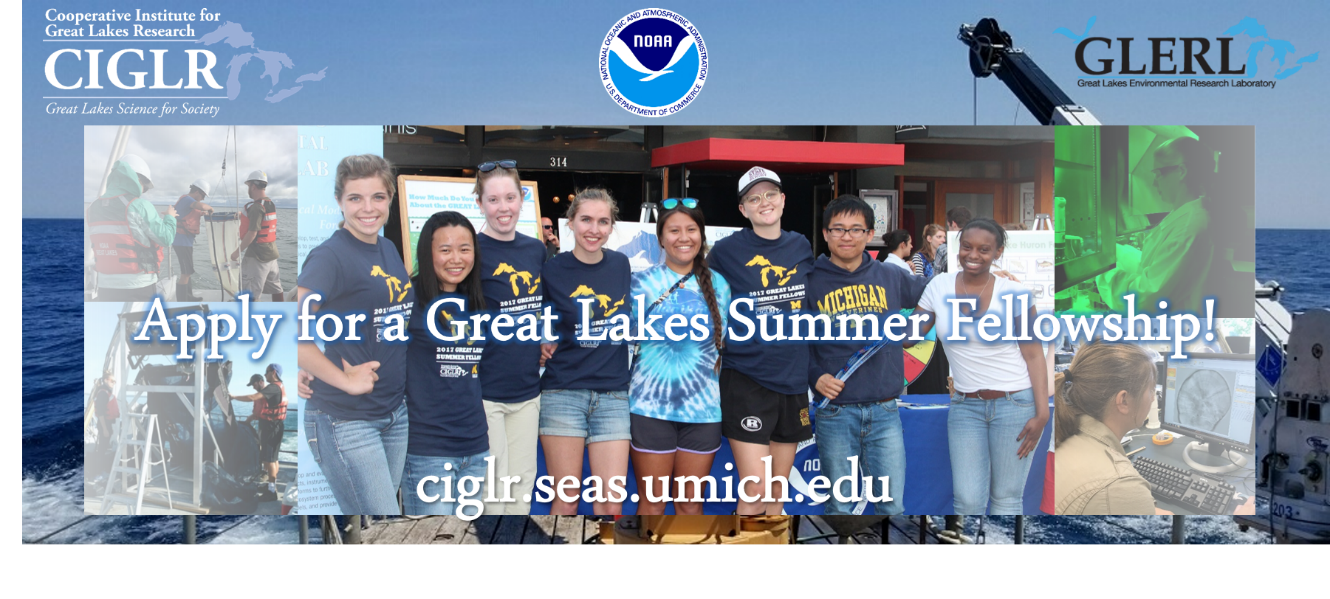 CIGLR is excited to announce the opening of our 2021 Great Lakes Summer Fellow applications! The Great Lakes Summer Fellows Program exposes students to a broad range of disciplines and provides an exciting opportunity for students to conduct research in the Great Lakes region under the mentorship of a CIGLR or GLERL scientist. We are offering 8 full-time, 12-week research fellowships on topics including invasive species impact assessment, data visualization, water quality modeling, phytoplankton and zooplankton variations, and ice cover modeling. The fellowship program will be conducted virtually to ensure health and safety during the ongoing COVID-19 pandemic. . We seek to use these fellowships to build diversity in STEM disciplines (science, technology, engineering and math) and strongly encourage applications from students who identify with groups that have been traditionally underrepresented in government and academic workforces.
CIGLR is excited to announce the opening of our 2021 Great Lakes Summer Fellow applications! The Great Lakes Summer Fellows Program exposes students to a broad range of disciplines and provides an exciting opportunity for students to conduct research in the Great Lakes region under the mentorship of a CIGLR or GLERL scientist. We are offering 8 full-time, 12-week research fellowships on topics including invasive species impact assessment, data visualization, water quality modeling, phytoplankton and zooplankton variations, and ice cover modeling. The fellowship program will be conducted virtually to ensure health and safety during the ongoing COVID-19 pandemic. . We seek to use these fellowships to build diversity in STEM disciplines (science, technology, engineering and math) and strongly encourage applications from students who identify with groups that have been traditionally underrepresented in government and academic workforces.
Applications are due Feb 19, 2021, 11:59pm EST! More here on eligibility & how to apply: Application Information
Engaging Great Lakes Shipping and Navigation Industry Stakeholders to Inform a New Short-term Ice Forecast
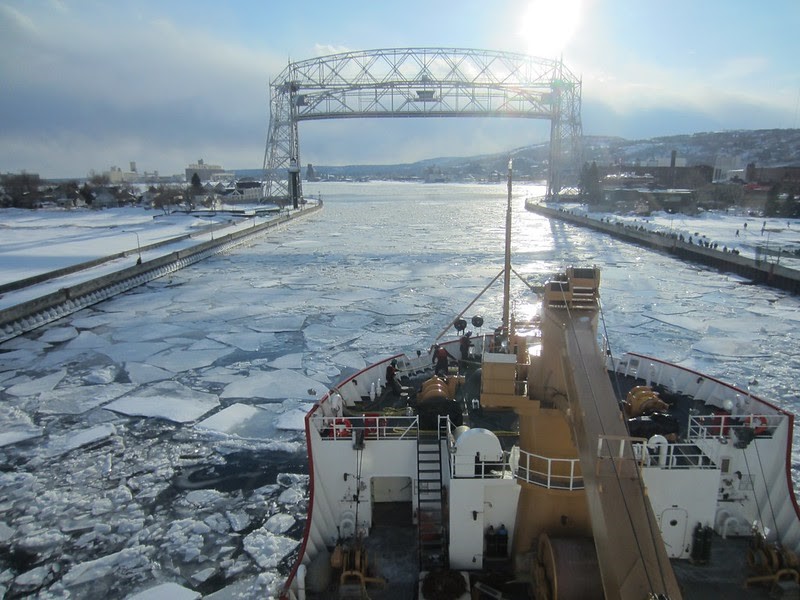
Connecting waterways and harbors present vessels with particularly challenging conditions for navigation as ice breaks, reforms, and thickens. Photo Credit: NOAA GLERL.
NOAA affiliates from the Cooperative Institute for Great Lakes Research (CIGLR) and the Great Lakes Integrated Sciences and Assessments program (GLISA) are engaging key Great Lakes stakeholders in a co-production study to inform development of a new, short-term Great Lakes ice forecast. CIGLR and GLISA researchers conducted a series of 10 interviews with representatives of the U.S. Army Corps of Engineers, U.S. and Canadian Coast Guards, and U.S. and Canadian shipping companies. Collectively, this industry supports more than 237,000 jobs and generates more than 35 billion dollars in economic activity for the Great Lakes region (Martin Associates, 2018). However, these stakeholders encounter considerable financial and safety risks seasonally as they plan for operations in icy conditions. Ice concentration and thickness can vary dramatically from mile to mile and minute to minute given variable weather conditions.
A new 5-day, short-term Great Lakes ice forecast will provide ship managers and operators with an additional decision-support tool in this high risk environment, predicting current and forecasted ice concentration, thickness, and velocity. Scientists at CIGLR and NOAA GLERL recently developed a coupled lake hydrodynamic-ice system [the Great Lakes Operational Forecast System (GLOFS), Anderson et al. 2018] to provide improved short-term forecasts of winter conditions. GLOFS models are currently transitioning from research to operations at either the NOAA National Ocean Service Center for Operational Oceanographic Products and Services (CO-OPS) or the National Ice Center (NIC) to provide this ice forecast guidance. Historically, the shipping industry has largely relied on current or past ice observations to make decisions in the absence of easily accessible forecasts. Engaging these stakeholders in the development process will ensure the new forecast includes the specific variables, thresholds, and geographic and temporal scales of interest to fully support their decision-making.
CIGLR Energizes Great Lakes Partnerships with Virtual 4th All Partners Meeting
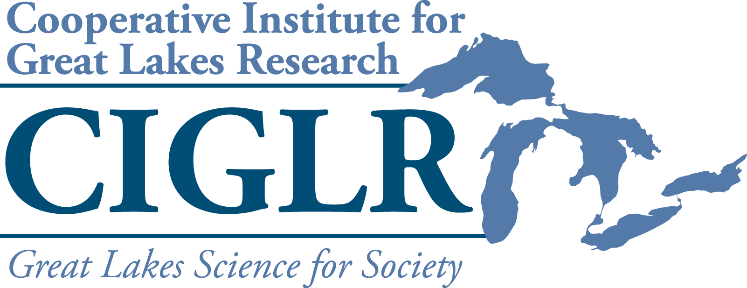
Each year, the Cooperative Institute for Great Lakes Research invites its Regional Consortium partners to NOAA GLERL for a 1.5-day meeting that aims to coordinate research goals and foster new research partnerships between NOAA GLERL and members of CIGLR’s Regional Consortium. This year, the meeting was held virtually from December 7-8, 2020 with more than 140 scientists from the CIGLR Research Institute, CIGLR Regional Consortium, and NOAA in attendance.
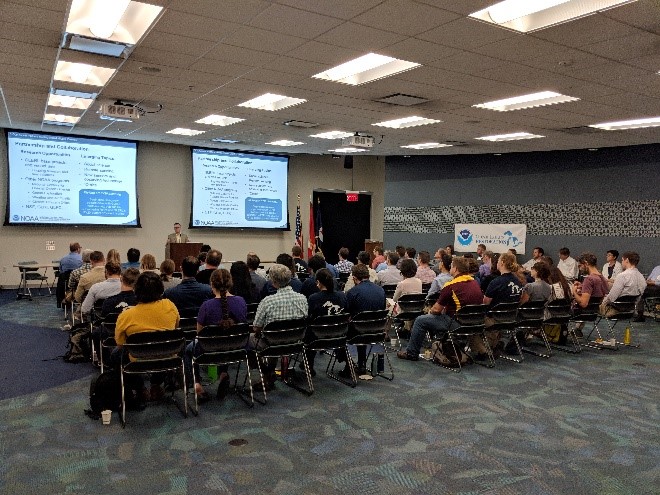
2019 CIGLR All Partners Meeting. Photo Credit: Michele Wensman.
The meeting started with welcome presentations by NOAA GLERL Director Deborah Lee and CIGLR Acting Director Thomas Johengen, who provided overviews of GLERL/CIGLR and laid out pathways to collaboration. Meeting sessions included presentations from Consortium partners that highlighted successful collaborations with CIGLR and NOAA GLERL, and presentations from each NOAA GLERL investigator that summarized their research and opportunities for collaboration. Two facilitated breakout sessions, focused on each of NOAA GLERL’s three science branches, provided opportunities for investigators from the CIGLR Regional Consortium, CIGLR Research Institute, and NOAA GLERL to discuss NOAA research challenges and opportunities. Facilitators led discussions on identifying collaboration opportunities ranging from immediate to long-term time scales, mechanisms for CIGLR to coordinate multi-partner collaborations, strategies for engaging NGO and business partners, barriers and limitations to collaboration, and ways to take advantage of infrastructure sharing.
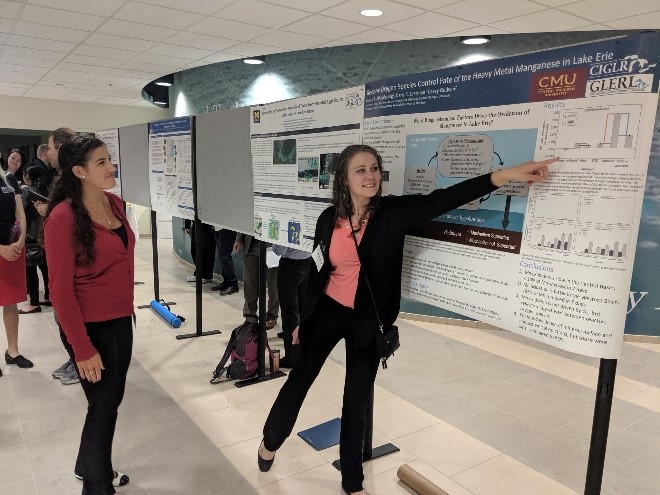
2019 CIGLR All Partners Meeting poster session. Photo Credit: Michele Wensman.
Participants included representatives from the Cleveland Water Alliance, Fondriest Environmental, Great Lakes Observing System, Great Lakes Environmental Center, LimnoTech, Michigan Environmental Council, National Wildlife Federation Great Lakes Regional Center, NOAA Great Lakes Environmental Research Laboratory, NOAA NESDIS, NOAA Cooperative Institutes, The Nature Conservancy Great Lakes Division, Central Michigan University, Cornell University, Grand Valley State University, Michigan Sea Grant, Lake Superior State University, Michigan State University, University of Michigan, Michigan Technological University, Ohio State University, University of Minnesota Duluth, University of Windsor, University of Wisconsin Milwaukee, and Wayne State University.
“I look forward to working with everyone, and to help keep these Great Lakes partnerships and collaborations thriving,” said CIGLR Acting Director Dr. Thomas Johengen.
Research Institute Spotlight: Andrew Camilleri
Monitoring of Lake Erie Benthos
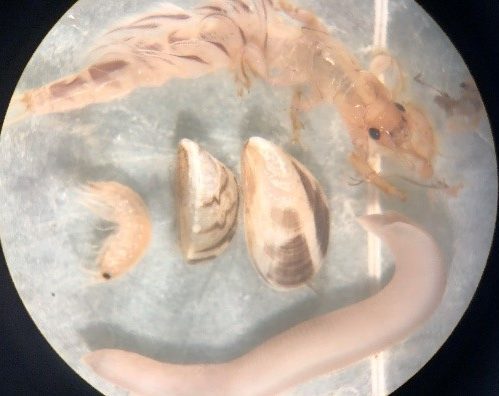
Microscope image of Lake Erie benthic sample. Photo Credit: Andrew Camilleri.
Benthic Ecology Research Technician Andrew Camilleri spent much of 2020 analyzing western Lake Erie sediment samples to measure their benthos, or living organisms, as part of a yearly monitoring effort in collaboration with the United States Geological Survey (USGS).

CIGLR Benthic Ecology Research Technician Andrew Camilleri shakes hands with EPA Administrator Wheeler on the R/V Lake Guardian. Photo Credit: CIGLR.
He was specifically analyzing the samples for densities of key invertebrates, including dreissenid mussels (zebra and quagga) and burrowing mayflies (Hexagenia). The establishment of zebra and quagga mussels brought on massive ecological change in the Great Lakes. Monitoring the overall distribution and size of dreissenids provides important information about the status of these invasive species and their preferred habitats.
Hexagenia were abundant in western Lake Erie until the 1950s, when they disappeared due to poor water quality caused by low oxygen conditions. Successful pollution abatement initiatives allowed Hexagenia to eventually recolonize the lake and reach relatively stable conditions by the late 1990s. “Being sensitive to low oxygen conditions and poor sediment quality, Hexagenia populations can be a very telling sign of overall lake health. That is why yearly monitoring efforts like this one are important,” says Camilleri.
